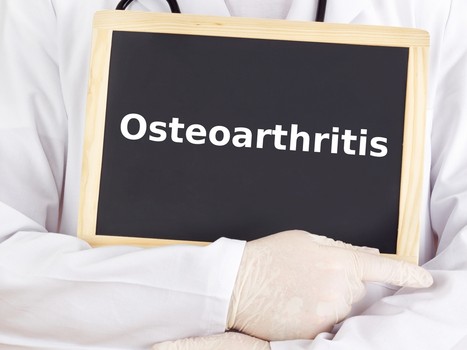Because of the intertwined nature of osteoarthritis and hypothyroidism, it sometimes becomes difficult for people to diagnose the exact condition they are suffering from. Both of these conditions cause almost similar symptoms, but the fact is they are not one condition. Both are different and are caused by different causes. Below here is a detailed account of each condition, which shows the clear distinction between the two conditions.
What is Hypothyroidism?
This is a medical condition that affects the thyroid gland. This is a very common disorder, it is estimated that more than 20 million people in United States are suffering from hypothyroidism. Thyroid gland is a very small and butterly-shapped gland located in front of your neck. Its role is to release two hormones into the body; thyroxin and triiodothyroine. These hormones are responsible for management of metabolism, cellular development and growth. In some instances, your thyroid might fail to produce these hormones and as a result you will develop hypothyroidism, a disorder that produces so many uncomfortable effects.
This disorder can affect both women and men; however, the disorder is more likely to affect other people than others. It is estimated that women aged above 40 years are more prone to Hypothyroidism attack and about 17% of women aged 60 years and above are diagnosed with this disorder.
Hypothyroidism can also be caused by other risk factors:
- Having had thyroid surgery
- Having undergone radiation therapy
- Having a close relative with the disease
- Having diabetes
Causes of Hypothyroidism
there are several reasons why an individual’s thyroid gland can become under active. The most common causes are:
- Autoimmune disease
- Pituitary disorder
- Thyroid surgery
- Exposure to radiation therapy
It is however unfortunate that it can be difficult to diagnose hypothyroidism in some patients especially those suffering from fibromyalgia.
Symptoms of Hypothyroidism
There is a wide variety of symptoms associated with Hypothyroidism. Most symptoms have a tendency of starting off mildly before progressing to becoming more chronic. Symptoms and signs of hypothyroidism include:
- Muscle and joint aches
- Cold sensitivity
- Fatigue
- Weight gain
- Cognitive disorders, including memory loss
- Depression
- Hair loss
- Puffiness around the eyes
Complications of Hypothyroidism
when left untreated, an under-performing thyroid gland can cause lots of problems. Possible problems include:
- Myxedema coma (a situation in which your heart rate and blood pressure drop causing you to lose consciousness)
- Miscarriage
- Heart disease
- Infertility
Diagnosing Hypothyroidism
testing hypothyroidism is very simple. The testing involves a simple blood test in which the level of thyroid hormone in your blood is tested.
Treating Hypothyroidism
in most people, this disorder of hypothyroidism easily treated. However, one major challenge with this kind of treatment is that it is lifelong and has to be monitored over and over again within that period. This treatment involves the medication levothyroxine, which helps to stimulate the thyroid to produce more hormones.
Osteoarthritis
Osteoarthritis is a medical condition that affects body joints. It is estimated that over 10 million people in the United States of America are suffering from this condition.
Symptoms of osteoarthritis
Osteoarthritis has a tendency of causing varying symptoms among different people and between different body joints in people who are suffering from it.
For instance, you might get a joint is severely damaged by OA but it does not cause any pain or any symptoms, but on the same time you might get another joint not severely damaged by OA but showing severe symptoms.
Three key characteristics of OA include:
- Damage to the cartilage- the smooth and strong surfaces that cover the bones and allow body joints to move without causing friction.
- Mild inflammation to the tissues in and around the joints
- Bony growths around the edge of the joints
These three characteristics can lead to the joint developing severe pain, stiffness and difficulties in performing certain workouts. OA is mostly known to occur in the hips, knees, small joints of the base of big toe and hand, and spine. However, OA can also affect almost any joint of the body.
Who gets osteoarthritis?
OA is commonly known to affect people who are aged 50 years and above, and it affects more women as compared to their men counterpart. It is mostly agreed that OA is a condition that most old people must go through. Though the changes of OA in old people are visible on x-rays, they do not always cause joint problems or any joint-related pain. Younger people can also get affected by OA, often due to injury or any other joint condition.
Managing Osteoarthritis
OA does not have a permanent cure, though; there are various treatments that can cure its symptoms. Mild symptoms can be relieved through suitable foot ware or by doing some light exercises. However, in more serious OA condition, it is necessary that treatment be applied.
Treatment options for OA may include:
- Medications, such as painkillers
- Non-drug treatments, such as weight loss and physiotherapy
- Surgery in a small number of cases, such as hip or knee replacement
Living with Osteoarthritis
OA is a long-term condition, and can affect one for the rest of his/her life. As such, it is important to know the best ways possible to live with OA without causing many problems to your mobility and general health. A part from receiving constant support from your health-care, it is important for you to look for your own health. This involves the responsibility of taking your medication as instructed by your health-care provider and ensuring that you are living a healthy lifestyle as much as possible. Alternatively, it would be good for you to speak to your GP or any other person living with the same condition and share on the ways on which you can improve your conditions.








